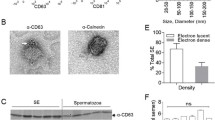Abstract
Human urine has been poorly investigated with regard to infection with human immunodeficiency virus (HIV). Here, we have studied the anti-infective functional properties of human urine against HIV. The effect of fresh urine pools on CCR5- and CXCR4-tropic HIV-1 was evaluated by using four in vitro mucosal models: reduction of infectivity of urine-treated HIV-1 particles, HIV-1 attachment to immature monocyte-derived dendritic cells (iMDDC), transfer of HIV-1 particles from iMDDC to autologous CD4 T cells, and HIV-1 transcytosis through epithelial cells. Human urine partially disrupted both CCR5- and CXCR4-tropic HIV-1 particles, moderately decreased the adsorption of HIV-1 on dendritic cells, and partially decreased the transfer of HIV-1 particles from dendritic cells to autologous T cells. These findings demonstrate partial inactivation of HIV infectivity and suggest that voiding urine after coitus could play a potential role in reducing the risk of HIV infection by both mechanically flushing out and neutralizing the infectivity of HIV-1 particles present in the genital tract.



Similar content being viewed by others
References
Gasparini P, Savoia A, Pignatti PF, Morandi C, Mezzelani P et al (1990) Search of HIV DNA by polymerase chain reaction in the urine sediments of seropositive individuals. Recenti Prog Med 81:35–36
Li JJ, Huang YQ, Poiesz BJ, Zaumetzger-Abbot L, Friedman-Kien AE (1992) Detection of human immunodeficiency virus type 1 (HIV-1) in urine cell pellets from HIV-1-seropositive individuals. J Clin Microbiol 30:1051–1055
Skolnik PR, Kosloff BR, Bechtel LJ, Huskins KR, Flynn T et al (1989) Absence of infectious HIV-1 in the urine of seropositive viremic subjects. J Infect Dis 160:1056–1060
Shugars DC, Alexander AL, Fu K, Freel SA (1999) Endogenous salivary inhibitors of human immunodeficiency virus. Arch Oral Biol 44:445–453
Cao YZ, Friedman-Kien AE, Mirabile M, Li XL, Alam M et al (1990) HIV-1 neutralizing antibodies in urine from seropositive individuals. J Acquir Immune Defic Syndr 3:195–199
Saidi H, Nasreddine N, Jenabian MA, Lecerf M, Schols D et al (2007) Differential in vitro inhibitory activity against HIV-1 of alpha-(1–3)- and alpha-(1–6)-D-mannose specific plant lectins: implication for microbicide development. J Transl Med 5:28
Saidi H, Eslahpazir J, Carbonneil C, Carthagena L, Requena M et al (2006) Differential modulation of human lactoferrin activity against both R5 and X4-HIV-1 adsorption on epithelial cells and dendritic cells by natural antibodies. J Immunol 177:5540–5549
Saidi H, Jenabian MA, Gombert B, Charpentier C, Mannarini A et al (2008) Pre-clinical development as microbicide of zinc tetra-ascorbo-camphorate, a novel terpenoid derivative: potent in vitro inhibitory activity against both R5- and X4-tropic HIV-1 strains without significant in vivo mucosal toxicity. AIDS Res Ther 5:10
Requena M, Bouhlal H, Nasreddine N, Saidi H, Gody JC et al (2008) Inhibition of HIV-1 transmission in trans from dendritic cells to CD4+ T lymphocytes by natural antibodies to the CRD domain of DC-SIGN purified from breast milk and intravenous immunoglobulins. Immunology 123:508–518
Hocini H, Becquart P, Bouhlal H, Chomont N, Ancuta P et al (2001) Active and selective transcytosis of cell-free human immunodeficiency virus through a tight polarized monolayer of human endometrial cells. J Virol 75:5370–5374
Geijtenbeek TB, Kwon DS, Torensma R, van Vliet SJ, van Duijnhoven GC et al (2000) DC-SIGN, a dendritic cell-specific HIV-1-binding protein that enhances trans-infection of T cells. Cell 100:587–597
Adachi J, Kumar C, Zhang Y, Olsen JV, Mann M (2006) The human urinary proteome contains more than 1500 proteins, including a large proportion of membrane proteins. Genome Biol 7:R80
Svanborg C, Agase W, Connell H, Frendéus B, Godaly G, Hang L, Hedlund M, Röllano P, Svensson M-L, Otto G, Wullt B (1999) Urinary tract infections and the mucosal immune system. In: PL Ogra, Mestecky J, Lamm ME, Strober W, McGhee JR, Bienenstock J (eds) Mucosal immonulogy. Academic press, San Diego, pp 1381–1393
Deiva K, Khiati A, Hery C, Salim H, Leclerc P et al (2006) CCR5-, DC-SIGN-dependent endocytosis and delayed reverse transcription after human immunodeficiency virus type 1 infection in human astrocytes. AIDS Res Hum Retroviruses 22:1152–1161
Fouchier RA, Groenink M, Kootstra NA, Tersmette M, Huisman HG et al (1992) Phenotype associated sequence variation in the third variable domain of the human immunodeficiency virus type 1 gp120 molecule. J Virol 66:3183–3317
Donovan B (2000) The repertoire of human efforts to avoid sexually transmissible diseases: past and present. Part 2: Strategies used during or after sex. Sex Transm Infect 76:88–93
Foxman B, Chi JW (1990) Health behavior and urinary tract infection in college-aged women. J Clin Epidemiol 43:329–337
Burns DN, Dieffenbach CW, Vermund SH (2010) Rethinking prevention of HIV type 1 infection. Clin Infect Dis 51:725–731
Acknowledgments
Grant support was received from the Agence Nationale de Recherches sur le SIDA et les Hépatites Virales (ANRS) and Institut National de la Santé et de la Recherche Médicale (INSERM), France.
Author information
Authors and Affiliations
Corresponding author
Rights and permissions
About this article
Cite this article
Auvert, B., Jenabian, MA., Saidi, H. et al. Partial inactivation of CCR5- and CXCR4- tropic HIV-1 by human urine. Arch Virol 156, 2181–2186 (2011). https://doi.org/10.1007/s00705-011-1114-9
Received:
Accepted:
Published:
Issue Date:
DOI: https://doi.org/10.1007/s00705-011-1114-9




